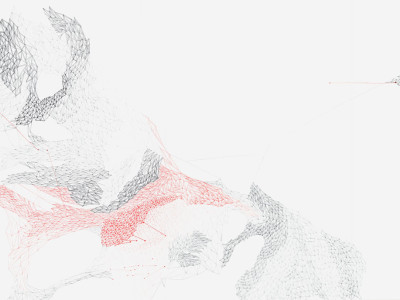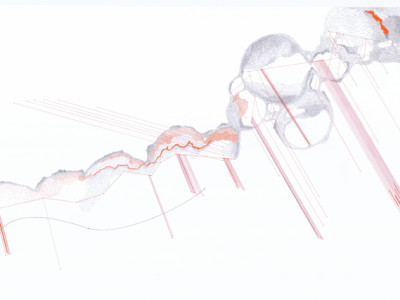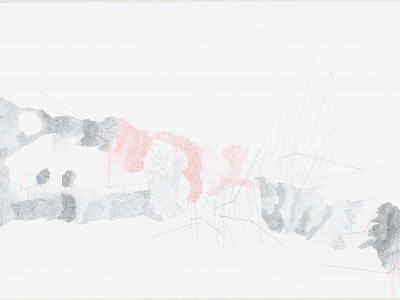Download Pdf file:
Frattale X, Frattale Y, Frattale n. 2, Frattale n. 3, Frattale n. 4, Frattale n. 6, Frattale n. 8
DESCRIBING A CLOUD
Observe a cloud: it is made of big mounds that consist of numerous protuberances, which at their turn include smaller swellings shaped by other swellings of inferior size and so forth down to the smallest visible dimension. The most conspicuous characteristic of a cloud is its irregular, “interrupted” structure. The clouds, therefore, are an example of non conventional geometric objects. Mathematics concentrated on simple shapes: straight lines, squares, regular polygons (pentagon, hexagon, octagon), circumferences and parabolas, spheres, cubes, circles, …. In nature, instead, regular shapes are mere exceptions. Where do you find a perfect cube, a perfect sphere? Trees, clouds, ferns, cauliflowers, lightings, mountains and rocks, coasts are all irregular, pointed, fragmented. This phenomenon is well explained by the famous mathematician Benoit B. Mandelbrot when he indicates this incapacity of geometry in front natures games: “Why is geometry often described as cold and arid? One of the reasons consists of its incapacity of describing the shape of a cloud, of a mountain, of a coast-line. Clouds are not spheres, mountains are not cones, coast-lines are not circles and the bark is not smooth. Even the light does not travel in a straight line”. These considerations led to the development of fractal geometry. Mandelbrot’s study “The Fractal Geometry of Nature” (1982) creates the term fractal in allusion to the Latin word fractus that means fragmented, irregular. Most probably nature is organizing itself according to fractal parameters because such a pattern increases surviving chances of itself by improving efficiency of the system (of the structured set of all elements. The fractals hence optimize the process of system evolution. For the same effect fractal organization can be found in other spontaneous phenomenon like social and economical systems and even, as has emerged from recent studies, connections to internet networks, physics of materials and of the cosmos refer to these rules. But what is a fractal? The most simple and intuitive definition describes it as a geometric figure in which a structural element is continuously repeated in all directions in continuously reduced scale, following recursive patterns of equations, functions or algorithms. By zooming in the figure reveals constantly the same recurrent structures and at every step new details. During a walk in the countryside or in a forest you can live a full immersion in nature in the midst of mountains, trees, herbs, flowers of any kind and size. A part from the unquestionable beauty of the environment, a closer glance can let you discover in the shapes of all these objects peculiar geometric properties. Think of a fern, at the branches of a tree, at a succulent plant, a sunflower, a snowflake under the microscope, the seacoasts, a river. You shall discover the magic of the fractal theory connected to the irregular shapes of nature, to its profound systems. I have approached the fractal theory with the purpose of interpreting and filtering it according to my sensibility, in order to create visions in which a poetic, evocative and rarefied geometry suggests , narrates and describes the mystery of nature. Nature has always been a fundamental category of western thought and, today, achieves an urgent topicality in contemporary reflection. Natural calamities, relation nature/culture, the future of environment, the limits of bio-ethic legislation… there is no way of considering nature less than the main protagonist of contemporary culture. Therefore I need to narrate it in its most hidden and deep expressions.
DESCRIVENDO UNA NUVOLA
Osserva una nuvola: essa è fatta di grandi cumuli costituiti di molte protuberanze, a loro volta contenenti rigonfiamenti più piccoli, fatti di altri rigonfiamenti, e così via, fino alle dimensioni più piccole che si è in grado di vedere. La caratteristica più appariscente della forma delle nuvole è la struttura fortemente irregolare, “interrotta”. Le nuvole, dunque, sono esempi di oggetti geometrici non convenzionali. La matematica amava le forme semplici: le linee rette, i quadrati, i poligoni regolari (pentagono, esagono, ottagono), le circonferenze e le parabole, sfere, cubi, cerchi,…In natura, al contrario, le figure regolari sono in realtà delle pure eccezioni. Dove si trova un cubo, o una sfera perfetta? Gli alberi, le nubi, le felci, i cavolfiori, i fulmini, le montagne e le rocce, le coste,… tutto appare irregolare, spigoloso, frammentato. Lo spiegò assai bene Benoit B. Mandelbrot,matematico, quando indicava tale incapacità della geometria di fronte al gioco della natura: “Perché la geometria viene spesso descritta come fredda e arida? Una delle ragioni sta nella sua incapacità di descrivere la forma di una nuvola, di una montagna, di una linea di costa. Le nuvole non sono sfere, le montagne non sono coni, le linee di costa non sono cerchi e la corteccia non è piana, e neppure la luce si propaga in linea retta”. E’ da queste considerazioni che nasce la geometria frattale che trova nell’opera di Mandelbrot The Fractal Geometry of Nature (1982) la coniazione del termine frattale (fractal in inglese), derivato dal latino fractus che vuol dire, appunto, frammentato, irregolare. La natura si auto-organizza secondo il modello frattale probabilmente perché questo modello è più funzionale alla sopravvivenza della natura stessa migliorando l’efficienza del sistema (dell’insieme strutturato degli elementi). I frattali realizzerebbero quindi l’ottimizzazione del sistema nel processo evolutivo. Per lo stesso motivo l’organizzazione frattale si riscontra anche in altri fenomeni spontanei: è elaborata spontaneamente nei sistemi sociali ed economici e anche, come è stato studiato recentemente, nell’organizzazione delle connessioni delle reti di Internet, della fisica dei materiali e del cosmo. Ma cos’è un frattale?La definizione più semplice e intuitiva lo descrive come una figura geometrica in cui un motivo identico si ripete in tutte le direzioni e a scala continuamente ridotta,attraverso equazioni,funzioni o algoritmi ricorsivi. Questo significa che ingrandendo la figura si otterranno forme ricorrenti e ad ogni ingrandimento essa rivelerà nuovi dettagli. Durante una passeggiata in campagna o in un bosco si è immersi nella natura fra montagne, alberi, erbe, fiori di tutti i tipi e di tutte le dimensioni. A parte l’indiscutibile bellezza dell’ambiente, un occhio più esperto può cogliere nella forma di tutti questi oggetti delle curiose proprietà geometriche. Pensate ad una felce, ai rami di un albero, ad una pianta grassa,un girasole,un fiocco di neve al microscopio,le coste del mare,un fiume e scoprirete la magia della teoria frattale,connessa alle forme irregolari della natura, ai suoi profondi sistemi. Ho attinto alla teoria frattale, interpretandola,filtrandola attraverso la mia sensibilità, per creare visioni dove una geometria poetica, evocativa e rarefatta, accenna e racconta,suggerisce e descrive il mistero della natura. Una natura che è da sempre una categoria fondamentale del pensiero occidentale e che oggi torna a imporsi con rinnovata urgenza alla riflessione contemporanea;disastri naturali,rapporto natura cultura, il futuro del paesaggio, frontiere del bio-diritto, impossibile non rendersi conto che la Natura è la grande protagonista della cultura contemporanea, da qui la mia necessità di “raccontarla” nelle sue forme più nascoste e profonde.



